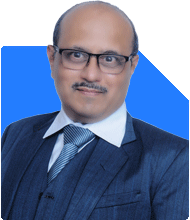Ramalingam Kalirajan |10893 Answers |Ask -Follow
Mutual Funds, Financial Planning Expert - Answered on Apr 05, 2024
He has an MBA in finance from the University of Madras and is a certified financial planner.
He is the director and chief financial planner at Holistic Investment, a Chennai-based firm that offers financial planning and wealth management advice.... more

Sir I am 78 years old. I have no liabilities. I have a house worth two corores. I am living with my daughter and son in law. They're extremely well off. Since I am living with my daughter I have no expenses. This is my background. My assets are as follows. 1) PPF RS.20lakhs. 2)PMYY SCHEME. 15Lakhs. 3) Fixed deposit 15 lakhs 4) Health insurance both 5lakhs each 5 ) Immovable property worth 5lakhs 6) Gold bond maturity value 1lakh 7) Physical gold and silver 20 lakhs 8) Shares worth 100000 rs.asof today 9) Mutual fund worth rs.18 lakhs as of today. Below l am giving details of the funds most of them purchased on issue price all regular growth. 1) Aditya Birla Sun Life focused equity fund Units 1200 2) DSP world gold fund growth regular Units 500 3) Franklin India flexi cap fund growth regular. Units 35 4) HDFC banking and financial services fund growth regular. Units 1160 5) HDFC defence fund growth regular Uni1000 6) HDFC mid cap fund growth regular Units 260 7) HDFC flexi cap fund growth regular Units 25 8) Hsbc value fund growth regular Units 430 9)Hsbc elss fund growth regular Units 490 10) Icici prudential Pharma and health care fund growth regular Units 780 11) Icici prudential India opportunities fund growth regular. Units 2200 12) Icici prudential manufacturing fund growth regular Units 3000 13) Icici prudential flexicap fund growth regular. Units5000 14) Icici prudential housing opportunities fund growth regular Units 2500 15) Icici prudential balanced advantage fund growth regular. Units. 550 16) Icici prudential psu equity fund growth regular. Units Units 2700 17) Kotak global innovation fund growth regular. Units 1200 18) Kotak international REIT fund growth regular. Units 500 19 ) Nippon india low duration fund growth regular. Units 10 20) Sbi blue chip fund growth regular Units 1000 21) Sbi infrastructure fund growth regular Units 500 22) Sundaram focused equity fund growth regular. Units 1300 23) Tata mid cap fund growth regular plan growth. Units 335 units 24)iUti nifty 500 fifty index fund growth regular. Units 18050 25)Uti flexi cap fund growth regular Units 1020 26)Uti small cap fund growth regular Units 5000 27) Uti master share units regular plan Units 210 28) Uti mid cap fund growth regular Units 700 29) Hdfc transportation fund growth regular Units 2500 Opinion required 1) I want to exit Kotak global innovation fund and Kotak international REIT fund and Dsp world gold fund. 2) I want to start 4 SIP of2500 rs. per month. a) Sbi blue chip fund b) Uti flexicap fund c) Multi asset fund of Hdfc or lclcl or Aditya Birla Sun Life d) not sure which fund Request you to suggest how to make best review of my investment. I would prefer to invest indirect growth instead of regular growth. Would it be convenient if invest inSWP or overnight fund or floater fund and give standing instruction to to invest in SIP? How to track my investments on daily basis ? Waiting eagerly for your reply. Your's sincerely PS: All nomination in the name of my wife. She is equally well invested in Bank FD PMVYYOJANA AND PPF and MF (very small amount of 5lakhs as today.
Exit Strategies:
Exiting funds that no longer align with your investment goals or if you wish to reduce exposure to certain sectors is a prudent move.
New SIP Allocation:
Starting SIPs in well-established funds across different categories such as large-cap, flexicap, and multi-asset funds can offer diversification and potential growth.
SWP or Systematic Withdrawal Plan:
SWP can be a suitable option if you wish to generate regular income from your investments. Consider reinvesting the redeemed amount into a liquid or floating rate fund, depending on your liquidity needs and risk tolerance.
Tracking Investments:
Utilize online platforms provided by mutual fund houses or third-party financial aggregators for tracking investments. Maintain a consolidated spreadsheet or use investment tracking apps for easy monitoring.
Nomination and Legal Aspects:
Ensure all investments and assets have proper nomination details and legal documentation. Keep your spouse informed about the investment details and maintain organized documents for easy access.
Consult a Financial Advisor:
Seek guidance from a qualified financial advisor to tailor your investment strategy according to your financial goals and risk tolerance.
Prioritize risk management and ensure your investments align with your objectives. Regularly review your portfolio's performance and make adjustments as needed to stay on track towards achieving your goals.
You may like to see similar questions and answers below
Ramalingam Kalirajan |10893 Answers |Ask -Follow
Mutual Funds, Financial Planning Expert - Answered on Jul 14, 2024
Milind Vadjikar | Answer |Ask -Follow
Insurance, Stocks, MF, PF Expert - Answered on Oct 08, 2024
Naveenn Kummar |235 Answers |Ask -Follow
Financial Planner, MF, Insurance Expert - Answered on Sep 09, 2025
Nitin Narkhede |113 Answers |Ask -Follow
MF, PF Expert - Answered on Dec 15, 2025
Nitin Narkhede |113 Answers |Ask -Follow
MF, PF Expert - Answered on Dec 15, 2025
Ramalingam Kalirajan |10893 Answers |Ask -Follow
Mutual Funds, Financial Planning Expert - Answered on Dec 15, 2025
Ramalingam Kalirajan |10893 Answers |Ask -Follow
Mutual Funds, Financial Planning Expert - Answered on Dec 15, 2025
Radheshyam Zanwar |6746 Answers |Ask -Follow
MHT-CET, IIT-JEE, NEET-UG Expert - Answered on Dec 15, 2025
Ramalingam Kalirajan |10893 Answers |Ask -Follow
Mutual Funds, Financial Planning Expert - Answered on Dec 15, 2025
Ramalingam Kalirajan |10893 Answers |Ask -Follow
Mutual Funds, Financial Planning Expert - Answered on Dec 15, 2025
Ramalingam Kalirajan |10893 Answers |Ask -Follow
Mutual Funds, Financial Planning Expert - Answered on Dec 15, 2025
Samraat Jadhav |2508 Answers |Ask -Follow
Stock Market Expert - Answered on Dec 15, 2025
Ramalingam Kalirajan |10893 Answers |Ask -Follow
Mutual Funds, Financial Planning Expert - Answered on Dec 15, 2025
























